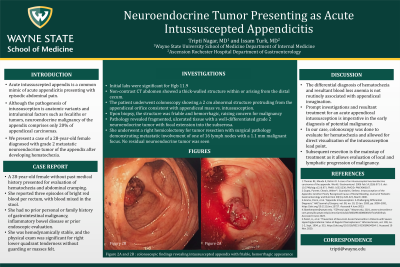Monday Poster Session
Category: Colon
P1738 - Neuroendocrine Tumor Presenting as Acute Intussuscepted Appendicitis
Monday, October 23, 2023
10:30 AM - 4:15 PM PT
Location: Exhibit Hall


Tripti Nagar, MD
Wayne State University
Detroit, MI
Presenting Author(s)
Tripti Nagar, MD1, Issam Turk, MD2
1Wayne State University, Detroit, MI; 2Ascension Providence Rochester Hospital, Rochester, MI
Introduction: Acute intussuscepted appendix is a common mimic of acute appendicitis presenting with episodic abdominal pain. Although the pathogenesis of intussusception i anatomic variants and intraluminal factors such as fecaliths or tumors, neuroendocrine malignancy of the appendix comprises only 20% of appendiceal carcinomas. We present a case of a 28 year old female diagnosed with grade 2 metastatic neuroendocrine tumor of the appendix after developing hematochezia.
Case Description/Methods: A 28-year-old female without past medical history presented for evaluation of hematochezia and abdominal cramping. She reported three episodes of bright red blood per rectum, with blood mixed in the stool. She had no prior personal or family history of gastrointestinal malignancy, inflammatory bowel disease or prior endoscopic evaluation. She was hemodynamically stable and the physical exam was significant for right lower quadrant tenderness without guarding or masses felt. Initial labs were significant for Hgb 11.9. Noncontrast CT abdomen showed a thick-walled structure within or arising from the distal cecum. The patient underwent colonoscopic evaluation showing a 2 cm abnormal structure protruding from the appendiceal orifice consistent with appendiceal mass vs. intussusception. The structure was biopsied and pathology revealed fragmented, ulcerated tissue with a well-differentiated grade 2 neuroendocrine tumor with focal extension into the subserosa. She underwent a right hemicolectomy for tumor resection with surgical pathology demonstrating metastatic involvement of one of 16 lymph nodes with a 1.1 mm malignant focus. No residual neuroendocrine tumor was seen.
Discussion: The differential diagnosis of hematochezia and resultant blood loss anemia is not routinely associated with appendiceal invagination. Prompt investigations and resultant treatment for an acute appendiceal intussusception is imperative in the early diagnosis of potential malignancy. In our case, colonoscopy was done to evaluate for hematochezia and allowed for direct visualization of the intussusception lead point. Subsequent resection is the mainstay of treatment as it allows evaluation of local and lymphatic progression of malignancy.
Disclosures:
Tripti Nagar, MD1, Issam Turk, MD2. P1738 - Neuroendocrine Tumor Presenting as Acute Intussuscepted Appendicitis, ACG 2023 Annual Scientific Meeting Abstracts. Vancouver, BC, Canada: American College of Gastroenterology.
1Wayne State University, Detroit, MI; 2Ascension Providence Rochester Hospital, Rochester, MI
Introduction: Acute intussuscepted appendix is a common mimic of acute appendicitis presenting with episodic abdominal pain. Although the pathogenesis of intussusception i anatomic variants and intraluminal factors such as fecaliths or tumors, neuroendocrine malignancy of the appendix comprises only 20% of appendiceal carcinomas. We present a case of a 28 year old female diagnosed with grade 2 metastatic neuroendocrine tumor of the appendix after developing hematochezia.
Case Description/Methods: A 28-year-old female without past medical history presented for evaluation of hematochezia and abdominal cramping. She reported three episodes of bright red blood per rectum, with blood mixed in the stool. She had no prior personal or family history of gastrointestinal malignancy, inflammatory bowel disease or prior endoscopic evaluation. She was hemodynamically stable and the physical exam was significant for right lower quadrant tenderness without guarding or masses felt. Initial labs were significant for Hgb 11.9. Noncontrast CT abdomen showed a thick-walled structure within or arising from the distal cecum. The patient underwent colonoscopic evaluation showing a 2 cm abnormal structure protruding from the appendiceal orifice consistent with appendiceal mass vs. intussusception. The structure was biopsied and pathology revealed fragmented, ulcerated tissue with a well-differentiated grade 2 neuroendocrine tumor with focal extension into the subserosa. She underwent a right hemicolectomy for tumor resection with surgical pathology demonstrating metastatic involvement of one of 16 lymph nodes with a 1.1 mm malignant focus. No residual neuroendocrine tumor was seen.
Discussion: The differential diagnosis of hematochezia and resultant blood loss anemia is not routinely associated with appendiceal invagination. Prompt investigations and resultant treatment for an acute appendiceal intussusception is imperative in the early diagnosis of potential malignancy. In our case, colonoscopy was done to evaluate for hematochezia and allowed for direct visualization of the intussusception lead point. Subsequent resection is the mainstay of treatment as it allows evaluation of local and lymphatic progression of malignancy.
Disclosures:
Tripti Nagar indicated no relevant financial relationships.
Issam Turk indicated no relevant financial relationships.
Tripti Nagar, MD1, Issam Turk, MD2. P1738 - Neuroendocrine Tumor Presenting as Acute Intussuscepted Appendicitis, ACG 2023 Annual Scientific Meeting Abstracts. Vancouver, BC, Canada: American College of Gastroenterology.
